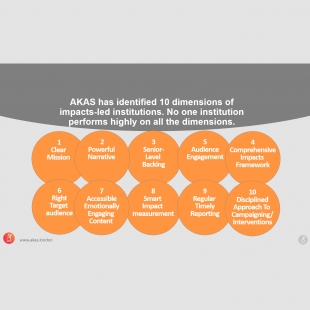10 characteristics of impact-led organisations

In my role as a co-founding director of AKAS, I recently attended the Market Research Society’s annual Impact conference, which showcases the latest thinking and best practice in the market research industry. One of the most popular sessions, entitled “Nudging Behaviour for Social Change”, featured The Big Issue, The Student Room and the Scottish Government detailing cases where they had all used nudging techniques to change behaviours. It struck me that in each case, one thing was conspicuously absent from the narrative: a framework for measuring the impact of their projects. How were they planning to evaluate whether the behaviour change they sought had actually occurred?
Research suggests that this omission is something of a norm among the majority of not-for-profit organisations. The 2016 US Forum One survey of employers, covering research institutions, advocacy organisations, associations, foundations, academic institutions and federal government, reveals that 71% of these organisations do not track impact metrics. Our view at AKAS, based on our experience of working with clients as well as researching other organisations, is that measuring the impact of an organisation’s work in relation to its media, public affairs, external relations and communications activities is a genuine struggle for many.
In January 2019, AKAS had the privilege of attending and partly facilitating a meeting of the Communications Directors of key international institutions, including the World Bank Group, the European Bank for Regional Development (EBRD), the International Monetary Fund (IMF), the Organisation for Economic Co-operation and Development (OECD), the United Nations (UN), UNICEF, the World Trade Organisation (WTO), and the United Nations Foundation. In preparing for that meeting, we drew on our own experience of working with news media organisations, NGOs, international institutions and philanthropic foundations, as well as on wider research, to identify key features of institutions which are impact-led. In this article, drawing on AKAS’ impact framework (which builds on the great work of the Centre For Investigative Reporting, Lindsay Green Barber, and James T. Hamilton’s Democracy Detectives as well as on that of our clients), we have distilled these down to 10 characteristics, highlighting organisations that perform well on each one. If it’s your ambition to lead an impact-led organisation, these ten steps will help you get there.
Characteristic #1: Have a clear mission. A mission is an organisation’s clearly articulated statement of why it exists. An impact-led organisation starts by articulating its mission and then encapsulates this in a pithy tagline. If an organisation does not know why it exists, it will have little chance of driving any systematic impact. In our research into international organisations, AKAS found that only 2 of the 23 leading international institutions had taglines that were clearly linked to their mission. These were the OECD with “Better Policies for Better Lives” and the World Bank Group’s “Ending Poverty. Investing in Opportunity”.
Characteristic #2: Create a powerful narrative. Impact-led organisations develop a strong narrative about the work they undertake, highlighting their key challenge (the jeopardy they face), as well as how the organisation is working to overcome this. A clear and powerful narrative helps to convey the direction that an organisation is heading in, using language that is accessible to the public and experts alike. AKAS’ analysis of the IMF’s communications demonstrates that the IMF’s deliberate “narrative economics” approach, with its analogy-based “A Time to Repair the Roof” campaign, exemplifies this characteristic: the campaign clearly articulates the challenge/jeopardy, namely that “while global recovery is taking root, it is not complete”; the sustained series of speeches and reports using a roof and weather metaphor (“Is the sun starting to break through”, “The tools we need to repair the roof”, and “Use this season of transformation to repair the roof while the sun is shining”) then communicate the (ongoing) solution to this challenge.
Characteristic #3: Ensure senior-level backing. If an impact strategy is to be successfully embedded in the full array of an organisation’s activities, it is critical that impact-led thinking is embraced at the most senior level. The OECD has recently adopted an impact-led approach. This has been achieved through the dogged commitment of the Public Affairs and Communications leadership team who presented impact-led thinking to the Secretary General and Directors on numerous occasions throughout 2018 and 2019. Similarly, the World Bank, through its work with Rockland-Dutton, has also developed an impressive impacts approach which has gained the endorsement of senior leaders in the External and Corporate Relations unit. Without the overt support of senior teams in an organisation, an impact-led approach is unlikely to take root, given the innovative, resource-heavy and disruptive nature of impact measurement.
Characteristic #4: Use a comprehensive impacts framework. Any organisation which is serious about introducing an impact-led approach must measure the impact of its activities and must do so systematically. This means that the organisation should dedicate resources (whether an individual or a team) to capturing all key types of metrics.
A comprehensive impacts framework (in communications) would measure five key types of metrics.
- Input metrics measure the resources used (in terms of people, money, infrastructure and technology) to support an organisation, as well as strategies, plans and guidelines.
- Output metrics measure the volume of content that an organisation creates, as well as the number of key face-to-face engagements.
- Short-term outcomes (reach and engagement) metrics measure the volume of people that an organisation or its content touches, and how audiences actively interact with the organisation and its content through liking, sharing, commenting on or other ‘lean forward’ types of actions.
- Real world impact metrics focus on the impact the organisation has beyond the immediate consumption of its content on the awareness, knowledge, attitudes and behaviours of members of the public (e.g. people becoming aware of a previously unknown injustice), influencers (e.g. media covering an important issue, or opinion formers retweeting content) and decision-makers (e.g. debating issues or developing/enforcing new policies/laws).
- Ultimate impacts focus on measuring how close an organisation is getting to fulfilling its mission (why it exists) and vision (what it is trying to achieve in the next 2-5 years) through the impact it has achieved at individual, influencer and decision-maker levels. Examples of ultimate impacts include numbers of lives saved, cures for diseases being found, poverty or homelessness being reduced, or education levels being increased.
Rather worryingly, the aforementioned Forum One survey conducted in the US in 2016 among non-profit institutions found that 80% of organisations tracked output metrics, 84% tracked reach metrics, 70% tracked engagement metrics but only 31% of organisations tracked metrics relating to impact.
In this category, UNICEF stands out with its AMEC-awarded impacts evaluation on the ground. The Guardian’s Global Development site, supported by the Bill & Melinda Gates Foundation (BMGF), is also seen as a leader in measuring the full range of output, outcome, engagement, real world and ultimate impacts. Research carried out by the Media Impact Project from USC has shown how the Guardian’s content has led to visitors becoming more aware of development goals, and to them taking pro-development actions.
Characteristic #5: Engage with your audiences. Impact-led organisations understand the needs, hopes, dreams and challenges of their key target audiences and ultimate beneficiaries. Understanding audiences is also key to accountability and to anchoring impact in the real world. Demonstrating the importance of this, as part of its initiative to understand lives and businesses, to listen and learn, the Bank of England has launched an outreach programme, which has involved its Governor, Mark Carney, and Chief Economist, Andy Haldane, putting considerable effort into touring the UK to connect directly with the public right across the country. In this, they have benefited from media coverage from Sky News and the FT. To date the programme has included discussions with some 9000 members of the public, 60 visits to policymakers and 600 presentations delivered to a range of audiences across the UK.
Characteristic #6: Target the right audience. Tailoring content to the right audience through the right channels is key to achieving any impact that involves a shift in awareness, attitudes and/or behaviours. For example, The Harvard Business Review recently explained how The American Enterprise Institute (AEI) switched its strategy from being output-led to impact-led. It did so in part by measuring their share of op-eds, compared to other thinktanks, in three leading publications: the New York Times, the Wall Street Journal, and the Washington Post. AEI targeted high-profile op-eds because they knew that a high proportion of policymakers read these. Over time, the AEI has brought in more funding as a result of this strategy. In addition, individuals and organisations perceive AEI as an impact leader and now consult them for advice on how to have an impact.
Characteristic #7: Provide accessible, emotionally engaging content. The quality of the content is of paramount importance in achieving impact in terms of shifting awareness, attitudes or behaviours. Content which communicates in a simple and direct manner is more likely to achieve an impact than content which is full of technical jargon. However, what is most likely to lead to impact is content that is emotionally engaging. In “Viral Marketing, The Science of Sharing”, Karen Nelson- Field details how she spent two years analysing the social media performance of 1000 randomly selected video clips and found that emotionally arousing or activating content was much more likely to be shared. Other research by Jonah Berger has also shown that New York Times articles that featured activating emotions such as awe or amazement were much more likely to be shared than others.
Characteristic #8: Be smart and creative in how you measure impact. The subjective nature of shifting mindsets and behaviours makes it hard to measure impact. Tracking real world impacts therefore requires creativity and a willingness to experiment with new approaches to data collection. The BMGF has led the way in experimenting and applying smart data approaches with their grantees. The Foundation has developed more sophisticated approaches to measuring impact than the standard ones which rely primarily on outcome metrics such as clicks and unique users. For example, BMGF has been using network analysis, propensity score matching and other advanced data analysis tools in order to arrive at a more holistic picture of the impact achieved.
Characteristic #9: Produce regular and timely reporting. Impact-led organisations track their performance and impact regularly. It is only by doing this that they can identify meaningful patterns and use insights concerning impact to drive their strategy, which in turn will enable them to fulfil their mission. The more regularly an organisation tracks its real-world impact, the more likely it is to be able to respond to and adjust its impact strategy, leading to better performance. For example, it is important to record on an ongoing basis the incidence of influencers (e.g. journalists, MPs, or policymakers) amplifying a message previously pushed by an organisation. Unfortunately, the majority of not-for-profit organisations measure their performance infrequently and their impact even less. According to the Forum One survey in the US in 2016, only 23% of not-for-profits measured their performance monthly, with a mere 6% measuring performance weekly or daily. Conversely, 63% of organisations only conducted performance measures quarterly/bi-annually or less frequently. 8% didn’t measure their performance at all.
Characteristic #10. Employ a disciplined approach to campaigning/behavioural interventions. Impact-led organisations are clear about the objectives of their campaigns/interventions, the target audiences they are aiming to reach, the messages they wish to push out, the channels they wish to use and, importantly, how they plan to evaluate the success of their campaign/interventions in terms of real world/ultimate impact. It was reference to this last point that was notably absent from the presentations delivered by The Big Issue, The Student Room and the Scottish Government at the MRS’ Impact 2019 conference.
Impact-led organisations approach campaigning in a disciplined way, reiterating the same (few) messages over a period of several years in order to drive awareness and impact. Their choice of platforms and channels of communication is dictated by where the target audiences consume their content. Organisations and marketers often fall into the trap of wanting to make frequent changes to the creative approach and campaign messages, either due to their insatiable thirst for creativity or because they believe that a campaign has been going on for too long. The problem with regularly changing campaigns is that the target audiences end up either not recognising the campaign at all or are left feeling confused and unclear about what the organisation is trying to communicate. The not-for-profit sector has a lot to learn from leading commercial brands which have repeated or built on the same messages for decades: McDonald’s has been using the “I’m lovin’ it” slogan since 2003, whilst Coca-Cola has repeatedly used the words “Taste” and “Real” in its US taglines since the 1950s. Unusually for the sector, the Australian Cancer Council’s “Slip Slop Slap” campaign, which launched in 1981, has been using the same tagline for over 30 years.
In summary, if your organisation aspires to having impact and being impact-led, there are ten steps on the road to realising that ambition:
1) Make sure you have a clear mission.
2) Articulate a powerful corporate narrative which states the challenges you are seeking to overcome, as well as how you plan to do this. Lock this into a memorable action-orientated and pithy tagline.
3) Ensure that the senior leadership team is fully on board with your approach.
4) Introduce a comprehensive impacts framework that measures inputs, outputs, outcomes, real world impacts and ultimate impacts.
5) Engage directly with your organisation’s target audience(s) and
6) Be clear about how you are targeting them.
7) Use content which is easily accessible and emotionally engaging.
8) Use innovative methods of data collection and collect different data to capture impact.
9) Measure your organisation’s impact and performance on a monthly (if not weekly) basis in order to gradually build trends and track success systematically.
10) Employ a comprehensive and disciplined approach to campaigns/interventions, including clear objectives and a primary target audience, crisp messages repeated over a long period of time on carefully selected platforms/channels and a framework for evaluating their success.
If you would like more information, please contact Luba Kassova on luba@addykassova.com or Richard Addy on richard@addykassova.com
If you would like to follow up on the topics discussed in this article, please contact Luba Kassova or Richard Addy on contact@akas.london







